First Published Research to Associate Lymphoma with Tattoos and Laser Removal
Recently peer-reviewed and published research from Lund University in Sweden found that tattooed individuals have a 21% higher risk of lymphoma compared to non-tattooed individuals, and laser removal of tattoos may ‘drastically’ increase this risk. Why is that?
Consider: A study by Vasold et al. revealed that laser irradiation of certain tattoo pigments, such as those containing azo compounds, led to a significant increase in hazardous decomposition products, including 2-methyl-5-nitroaniline (a known carcinogen), 4-nitrotoluene, and 2,5-dichloroaniline. For instance, the concentration of 2-methyl-5-nitroaniline increased 33-fold after laser exposure, and 4-nitrotoluene increased 45-fold. Risks increase because the laser fragments the ink particles into smaller pieces, forming new chemical species, some of which are dangerous. The smaller ink fragments move out of the dermal layer and into the lymphatic filtering system, potentially clogging it with these dangerous toxic and carcinogenic by-products.
These two studies are not the only ones but raise important questions about the safety of not only tattoo inks but also the safety of some tattoo removal methods. In this blog article, we’ll explore various tattoo removal options and discuss why an alternative like Tatt2Away is the prudent choice.
Sources:
- Study – Nielsen, J., Jerkeman, M., & Jöud, A. (2024). Tattoos as a risk factor for malignant lymphoma: A population-based case-control study. eClinicalMedicine, 50, 102388. doi:10.1016/j.eclinm.2024.102388.
- Vasold R, Naarmann N, Ulrich H, et al. Tattoo pigments are cleaved by laser light: chemical analysis in vitro provides evidence for hazardous compounds. Photochem Photobiol. 2004;80(2):185-190. doi:10.1562/2004-05-17-RA-170.
- Fraser TR, Ross KE, Alexander U, Lenehan CE. Current knowledge of the degradation products of tattoo pigments by sunlight, laser irradiation, and metabolism: a systematic review. J Expo Sci Environ Epidemiol. 2022;32(3):343-355. doi:10.1038/s41370-021-00364-y.
Understanding Tattoos and the Lymphatic System

Tattoos have become increasingly popular in today’s world, but even so, some people might not know how they are applied. Tattoos are created by placing ink into the dermal layer of the skin. Larger ink particles remain trapped within and between skin cells, while smaller particles continually move into the lymphatic system. The body’s natural immune response is to try to remove the ink from the skin and process it out through the lymphatic system. The lymphatic system is a network of tubes throughout the body that is part of the circulatory and immune systems. It is responsible for removing excess water and potential antigens from the body and forming antibodies to fight viruses, bacteria, and other pathogens. Most tattoo ink particles are too big to remove naturally through the body, but over time, as the ink naturally breaks down, which is when you would see fading in a tattoo, the lymphatic system naturally transports these ink particles to the lymph nodes.
Can Tattoos Cause Cancer?

Overview of the Study’s Findings on Tattoos, Laser Removal, and Lymphoma
The C. Nielsen Study identified a connection between tattoos and lymphoma, particularly emphasising how ink particles can migrate to the lymphatic system. It revealed that tattoo ink particles can accumulate in the lymph nodes, raising concerns about long-term health effects, including the finding that “laser treatment for tattoo removal seemed to drastically modify the risk” (p.7).
Christel Nielsen comments on their research findings, stating, “We found that the risk of developing lymphoma was 21% higher among those who were tattooed…. We already know that when tattoo ink is injected into the skin, the body interprets this as a foreign substance that shouldn’t be there, and the immune system is activated. A large portion of the ink is transported away from the skin to the lymph nodes, where it is deposited.”
In the matched analysis, the study found that individuals with tattoos had a higher adjusted risk of developing malignant lymphoma compared to those without tattoos, with an incidence rate ratio (IRR) of 1.21 (95% CI 0.99–1.48). This IRR of 1.21 suggests a 21% increased risk, although the confidence interval shows some uncertainty, with the lower bound slightly under 1.0. When the matching was broken, the risk estimate stayed elevated but became more precise, with an IRR of 1.18 (95% CI 1.01–1.39), reinforcing the possible link between tattoos and lymphoma. (Study p.1)
The study also pointed out that the risk of lymphoma was highest in people who had less than two years between getting their first tattoo and the index year, with an IRR of 1.81 (95% CI 1.03–3.20). This suggests that getting tattoos more recently may pose a higher risk. Interestingly, the risk seemed to drop with intermediate exposure times (three to ten years) but appeared to rise again in people who had their first tattoo 11 or more years before the index year, with an IRR of 1.19 (95% CI 0.94–1.50.
Another key finding was that the risk of lymphoma did not increase with a larger total tattooed skin area. In fact, the highest risk was seen in people with tattoos smaller than the size of one hand palm. The study also compared different tattoo colour schemes and found similar risk estimates for black/grey tattoos and those that included colour.
Observations Regarding Laser Tattoo Removal
Importantly, the study observes that “laser treatment for tattoo removal seems to drastically modify [or increase] the risk of lymphoma.” Among individuals with tattoos who underwent laser removal, the matched analysis indicated a relative risk of lymphoma with an IRR of 2.63 (95% CI 0.96–7.18), suggesting a 163% increase in relative risk. Although this estimate has a wide confidence interval due to the small sample size, it suggests that laser tattoo removal could significantly modify and increase the risk of lymphoma. When additional data were included in an unmatched analysis, the risk estimate was even higher, with an IRR of 2.99 (95% CI 1.37–6.52), suggesting a 199% increased risk, indicating a potentially strong effect modification by laser treatment. See table below.
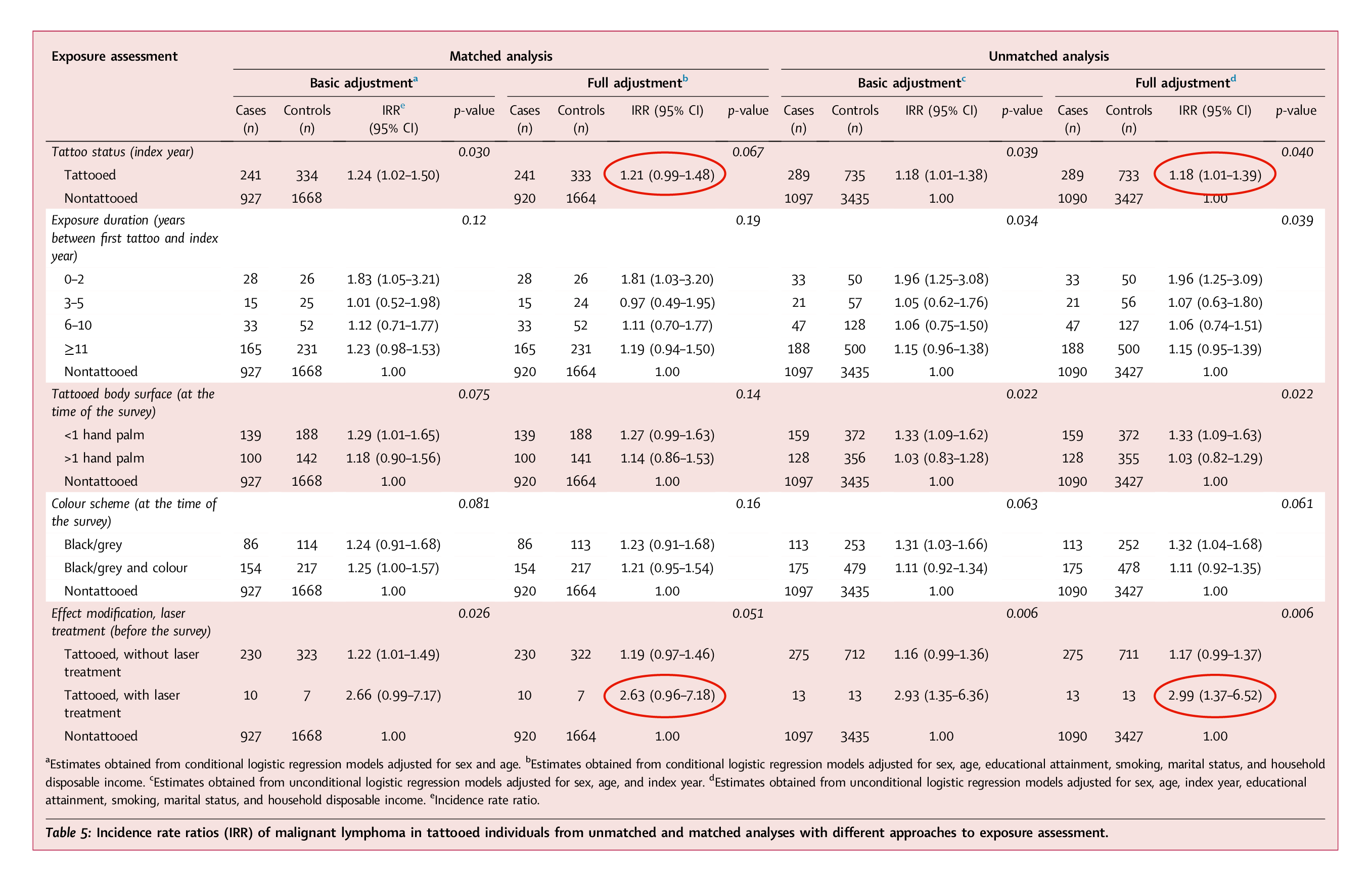
These findings from the Lund University study emphasise the need for further research to better understand the relationship between tattoo exposure, particularly with laser removal, and the risk of malignant lymphoma. Tatt2Away strongly encourages all prospective clients to carefully read the C. Nielsen, Lund University Study and all other research articles referenced here.
Source:
- Study – Nielsen, J., Jerkeman, M., & Jöud, A. (2024). Tattoos as a risk factor for malignant lymphoma: A population-based case-control study. eClinicalMedicine, 50, 102388. doi:10.1016/j.eclinm.2024.102388.
Mechanisms of the Laser Removal Process
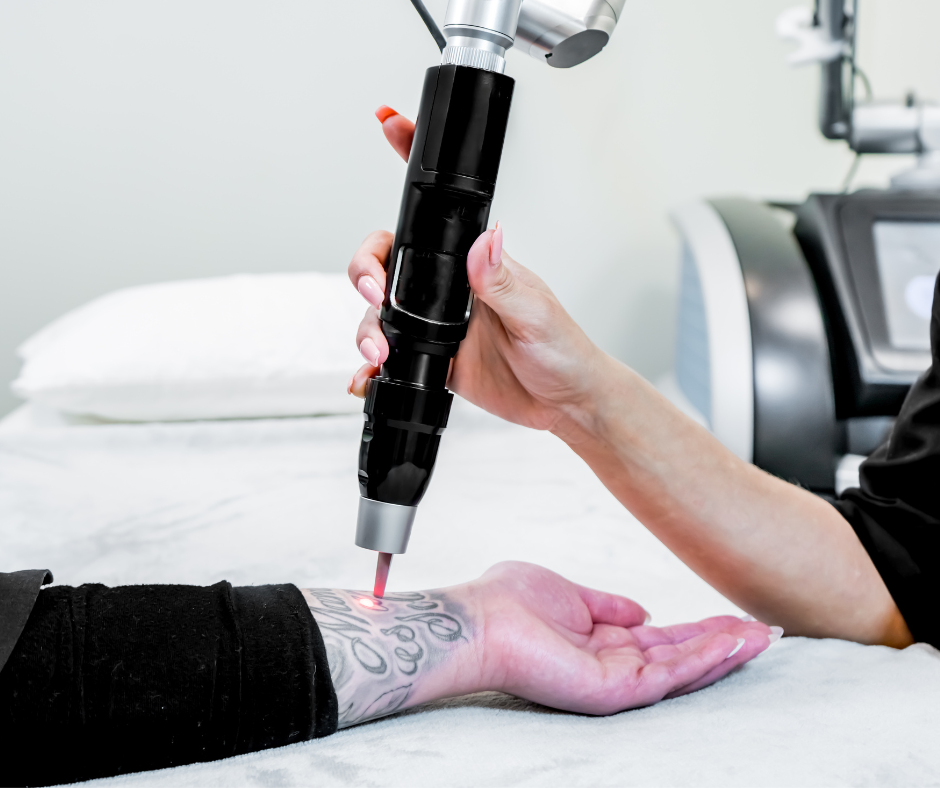
When understanding why tattoos and laser tattoo removal are linked to lymphoma, it is important to understand how laser tattoo removal works. Laser tattoo removal involves several key mechanisms that work together to break down the tattoo pigments within the skin, enabling their eventual removal by the body. The mechanisms are:
1. Selective Photothermolysis
Selective photothermolysis is the primary mechanism behind laser tattoo removal. This technique uses the principle that certain structures in the skin, such as tattoo pigments, selectively absorb specific wavelengths of laser light. According to Anderson and Parrish, the laser’s wavelength must be carefully selected to match the absorption spectrum of the tattoo pigment, ensuring that the pigment absorbs the energy while minimising damage to the surrounding tissue. Upon absorption, the laser energy is rapidly converted into heat, leading to the thermal denaturation and fragmentation of the pigment particles. The duration of the laser pulse is crucial, as it is chosen to be shorter than the thermal relaxation time of the target pigment, preventing heat diffusion into the surrounding tissues and ensuring precise and localised damage.
Sources:
Anderson RR, Parrish JA. Selective photothermolysis: precise microsurgery by selective absorption of pulsed radiation. Science. 1983;220(4596):524-527. doi:10.1126/science.6836297.
2. Photothermal Decomposition
Following the absorption of laser energy by the pigment, a rapid increase in temperature causes the pigment particles to undergo photothermal decomposition. According to Vasold et al., this process involves the breaking of chemical bonds within the pigment molecules, resulting in the fragmentation of the pigment into smaller particles or its complete breakdown into gaseous by-products. Specifically, the decomposition of certain azo pigments during laser irradiation can produce hazardous chemical by-products such as 2-methyl-5-nitroaniline, 4-nitrotoluene, and other potentially carcinogenic compounds. Additionally, gaseous by-products such as carbon monoxide (CO), carbon dioxide (CO₂), and hydrogen cyanide (HCN) can also be released. These by-products pose significant health risks if they are not effectively cleared from the body and could contribute to adverse health outcomes when absorbed into the bloodstream or lymphatic system.
Source:
Vasold R, Naarmann N, Ulrich H, et al. Tattoo pigments are cleaved by laser light: chemical analysis in vitro provides evidence for hazardous compounds. Photochem Photobiol. 2004;80(2):185-190. doi:10.1562/2004-05-17-RA-170.
Fraser TR, Ross KE, Alexander U, Lenehan CE. Current knowledge of the degradation products of tattoo pigments by sunlight, laser irradiation, and metabolism: a systematic review. J Expo Sci Environ Epidemiol. 2022;32(3):343-355. doi:10.1038/s41370-021-00364-y.
3. Plasma Formation and Acoustic Shock Waves
At sufficiently high laser intensities, plasma formation occurs at the site of the pigment particles. Plasma is an ionised state of matter that generates intense heat and light. The rapid expansion of the plasma creates acoustic shock waves, which propagate through the surrounding tissue. These shock waves contribute to the mechanical disruption of the pigment particles, further fragmenting them into smaller pieces (sub-particles and potentially unsafe novel molecular species) that can be more easily removed by the body’s lymphatic system.
Source:
Cencic B, Grad L, Možina J, Jezeršek M. Optodynamic monitoring of laser tattoo removal. J Biomed Opt. 2012;17(4):047003. doi:10.1117/1.JBO.17.4.047003.
Vasold R, Naarmann N, Ulrich H, et al. Tattoo pigments are cleaved by laser light: chemical analysis in vitro provides evidence for hazardous compounds. Photochem Photobiol. 2004;80(2):185-190. doi:10.1562/2004-05-17-RA-170.
Fraser TR, Ross KE, Alexander U, Lenehan CE. Current knowledge of the degradation products of tattoo pigments by sunlight, laser irradiation, and metabolism: a systematic review. J Expo Sci Environ Epidemiol. 2022;32(3):343-355. doi:10.1038/s41370-021-00364-y.
4. Pigment Fragmentation and Lymphatic Transport
The fragmentation of tattoo pigments into smaller particles during laser tattoo removal allows these particles to be absorbed by the body’s immune cells, particularly macrophages. These immune cells engulf the fragmented pigments and attempt to process and eliminate them through the body’s lymphatic system. The lymphatic system plays a crucial role in filtering out foreign substances, including tattoo pigments, and directing them towards elimination routes such as the liver and kidneys. However, the process of “clearing” these particles from the body is not always straightforward or entirely effective.
Once the pigments are engulfed by macrophages, they are transported to lymph nodes, which act as filtration points within the lymphatic system. Here, the pigments can either be further broken down, transported to other organs for excretion, or, as often occurs, become trapped. The entrapment of these pigment particles in lymph nodes can lead to their accumulation, which raises potential health concerns. Over time, this accumulation can result in chronic inflammation, and the persistent presence of foreign particles may contribute to the development of lymphoma, as suggested by the Lund University study.
Moreover, the process of laser tattoo removal can generate hazardous degradation products, such as hydrogen cyanide and carcinogenic aromatic amines. These by-products are particularly concerning because they are smaller, more reactive, and potentially more harmful than the original tattoo pigments. As they are transported through the lymphatic system, they may not be efficiently cleared, leading to their deposition in lymph nodes, the liver, lungs, and other organs. This incomplete clearance increases the risk of systemic exposure to these toxic substances, which can contribute to long-term health effects, including a potential increased risk of cancer.
The body’s ability to “clear” these particles also depends on various factors, including the size and chemical composition of the pigment particles, the individual’s immune system efficiency, and the frequency and intensity of laser treatments. In some cases, the lymphatic system may become overwhelmed by the volume of fragmented pigments, leading to incomplete elimination and greater retention of potentially harmful substances within the body. This incomplete clearance and potential accumulation highlight the need for careful consideration of the long-term health risks associated with laser tattoo removal.
Sources:
Khunger N, Molpariya A, Khunger A. Complications of tattoos and tattoo removal: Stop and think before you ink. J Cutan Aesthet Surg. 2015;8(1):30-36. doi:10.4103/0974-2077.155073.
Fraser TR, Ross KE, Alexander U, Lenehan CE. Current knowledge of the degradation products of tattoo pigments by sunlight, laser irradiation, and metabolism: a systematic review. J Expo Sci Environ Epidemiol. 2022;32(3):343-355. doi:10.1038/s41370-021-00364-y.
Nielsen, J., Jerkeman, M., & Jöud, A. (2024). Tattoos as a risk factor for malignant lymphoma: A population-based case-control study. eClinicalMedicine, 50, 102388. doi:10.1016/j.eclinm.2024.102388.
5. Chemical Decomposition and Formation of Hazardous Compounds
Laser-induced breakdown or degradation of tattoo pigments can lead to the formation of new, potentially hazardous chemical compounds. For instance, the decomposition of azo pigments by laser irradiation can result in the production of toxic and carcinogenic substances, such as 2-methyl-5-nitroaniline and 4-nitrotoluene. These newly formed chemicals can be absorbed into the body’s lymphatic system, where they pose additional health risks, particularly if they accumulate in lymph nodes or other organs. (See Table 5 below from the Fraser study on degradation products of tattoo ink pigments.)
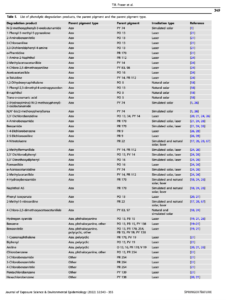
Table 5 from Current knowledge of the degradation products of tattoo pigments Study by Fraser et al.
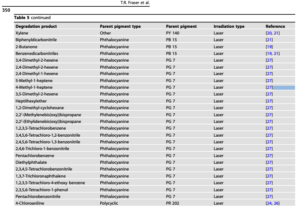
Table 5 cont. from Current knowledge of the degradation products of tattoo pigments Study by Fraser et al.
Source:
Vasold R, Naarmann N, Ulrich H, et al. Tattoo pigments are cleaved by laser light: chemical analysis in vitro provides evidence for hazardous compounds. Photochem Photobiol. 2004;80(2):185-190. doi:10.1562/2004-05-17-RA-170.
Fraser TR, Ross KE, Alexander U, Lenehan CE. Current knowledge of the degradation products of tattoo pigments by sunlight, laser irradiation, and metabolism: a systematic review. J Expo Sci Environ Epidemiol. 2022;32(3):343-355. doi:10.1038/s41370-021-00364-y.
Ink Ingredients & the Risks
In 2022, the European Union introduced a ban on certain types of tattoo inks. This ban was implemented to monitor and reduce the number of harmful chemicals and toxins commonly found in tattoo inks. Currently, the United States has no regulations or restrictions on tattoo inks. However, a study published in Analytical Chemistry tested popular tattoo inks from nine brands commonly used in the US, including both major and smaller manufacturers. Of the 54 inks tested, 45 were found to contain unlisted additives and pigments, such as poly(ethylene glycol), propylene glycol, and higher alkanes. These additives could potentially cause allergic reactions or other, more serious health issues. The findings highlight a significant concern regarding the accuracy of tattoo ink labelling in the US and the lack of regulation ensuring the safety of tattoo ink ingredients.
Non-laser Removal with Tatt2Away
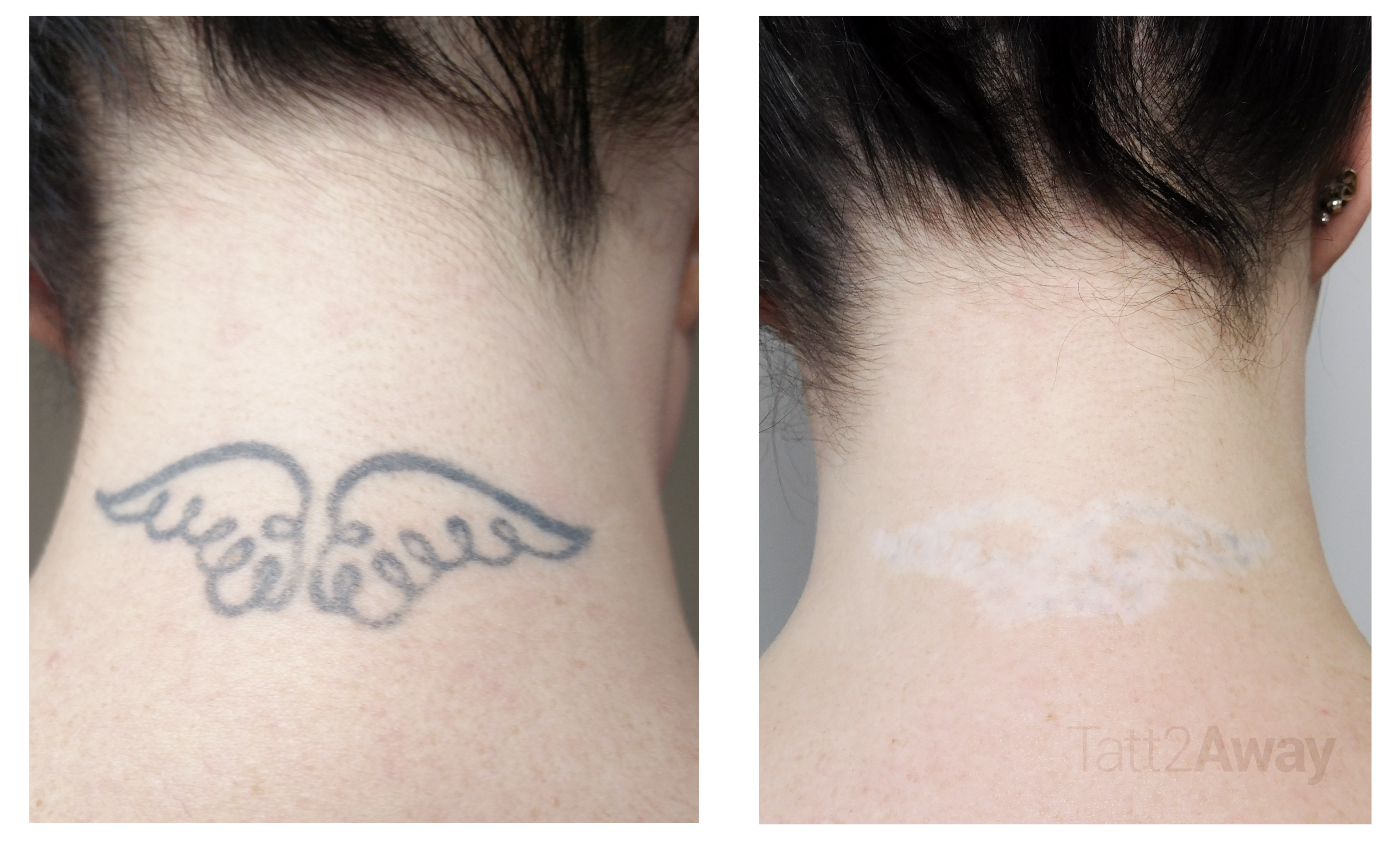
Image: Tatt2Away Non-Laser Tattoo Removal - Before and After
The C. Neilsen Study, recognised by Lund University, has sparked a need for further investigation into the suggested link between tattoos, laser removal, and lymphoma. This should be of interest to anyone considering laser tattoo removal.
Tatt2Away is a non-laser tattoo removal method that uses the body’s natural healing process to lift and remove tattoo ink from the skin. It employs a superficial precision dermabrasion technique to create small controlled abrasions over the unwanted tattoo. During this process, a proprietary natural-ingredient solution called Teprsol is applied, aiding the body’s natural healing process to safely and naturally expel the ink particles in the form of an eschar, or more simply, a debris scab. Tatt2Away is effective on all ink colours, works on cosmetic ink and permanent makeup, and is suitable for all skin types. In our opinion, Tatt2Away is an effective and sensible choice with no risk from carcinogenic laser-cleaved pigment molecules.
Conclusion
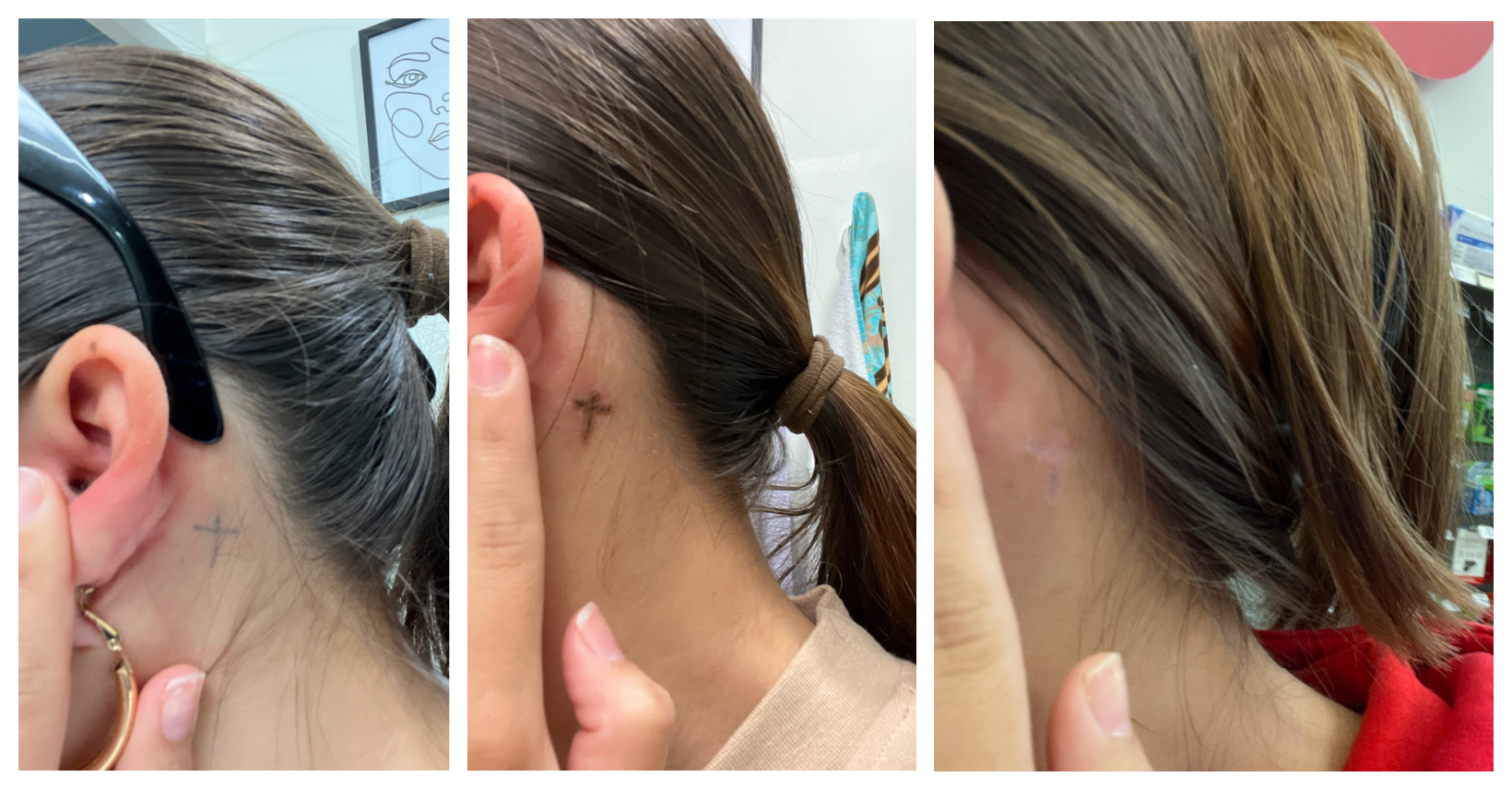
Image: A person's journey of Non-Laser Tattoo Removal With Tatt2Away
In light of the above, and as long as laser tattoo removal remains a widely used method, understanding the potential risks, particularly the possibility of dangerous by-products moving into the lymphatic system, is critical for every client’s informed consent. These factors raise significant health and safety concerns regarding the health impacts, including a potentially increased risk of lymphoma.
In response to the opinions of experts from institutions like Dana-Farber, Harvard, and NYU Langone, who have downplayed the significance of the Lund University study in a recent CNN article, it is essential to highlight why the findings from this study remain statistically relevant. Despite the critiques, the study was peer-reviewed by other experts in the field who deemed it worthy of publication. The study’s large cohort—nearly 12,000 people (3,000 with lymphoma)—provides a solid data set, bolstering the validity of its conclusions. The experts questioned the findings, particularly the lack of a direct link between tattoo size and lymphoma risk, and the relatively small sample of 26 individuals (13 cases/13 controls) who underwent laser tattoo removal. However, the study’s unmatched statistical analysis, which included all data, revealed an incident rate ratio (IRR 2.99 (95% CI 1.37–6.52)) suggesting a 199% increased risk of malignant lymphoma in individuals who had laser tattoo removal. This is supported by a statistically significant p-value of 0.006, which indicates the results are not due to random chance but reflect a significant association.
Interpretation of p-value:
- A p-value of 0.05 means there is a 5% probability that the observed results happened by chance.
- A p-value of 0.006 means there is only a 0.6% probability of getting the observed results by chance.
- The smaller the p-value, the more likely the observed result(s) is real and not caused by random chance.
Therefore, while further research is certainly necessary, the Lund University study should not be dismissed lightly; it offers a compelling and cautious perspective on the potential risks associated with tattoos and their removal. Additionally, numerous other research articles cited in this blog further support the hypothesis that laser tattoo removal creates carcinogenic by-products in the dermis, which can enter the lymphatic system and potentially lead to lymphatic cancer.
While more research is needed to fully understand all aspects of tattoo removal and its effects on health, choosing a method like Tatt2Away is a wise choice considering the research presented in this blog.
Given these considerations, it is evident that exploring alternative tattoo removal methods is not only wise but also prudent. Tatt2Away offers a different approach, one that mitigates these risks by avoiding the carcinogenic by-products from fragmenting ink pigments.
Learn more about Tatt2Away’s natural and effective non-laser tattoo removal method—click how it works or visit our tattoo removal blog.
All Listed Sources:
Nielsen, J., Jerkeman, M., & Jöud, A. (2024). Tattoos as a risk factor for malignant lymphoma: A population-based case-control study. eClinicalMedicine, 50, 102388. doi:10.1016/j.eclinm.2024.102388.
Vasold R, Naarmann N, Ulrich H, et al. Tattoo pigments are cleaved by laser light: chemical analysis in vitro provides evidence for hazardous compounds. Photochem Photobiol. 2004;80(2):185-190. doi:10.1562/2004-05-17-RA-170.
Khunger N, Molpariya A, Khunger A. Complications of tattoos and tattoo removal: Stop and think before you ink. J Cutan Aesthet Surg. 2015;8(1):30-36. doi:10.4103/0974-2077.155073.
Fraser TR, Ross KE, Alexander U, Lenehan CE. Current knowledge of the degradation products of tattoo pigments by sunlight, laser irradiation, and metabolism: a systematic review. J Expo Sci Environ Epidemiol. 2022;32(3):343-355. doi:10.1038/s41370-021-00364-y.
Anderson RR, Parrish JA. Selective photothermolysis: precise microsurgery by selective absorption of pulsed radiation. Science. 1983;220(4596):524-527. doi:10.1126/science.6836297.
Cencic B, Grad L, Možina J, Jezeršek M. Optodynamic monitoring of laser tattoo removal. J Biomed Opt. 2012;17(4):047003. doi:10.1117/1.JBO.17.4.047003.
Start your tattoo removal journey, find a Tatt2Away location, and book a no-cost consultation (valued at A$100!) today.


